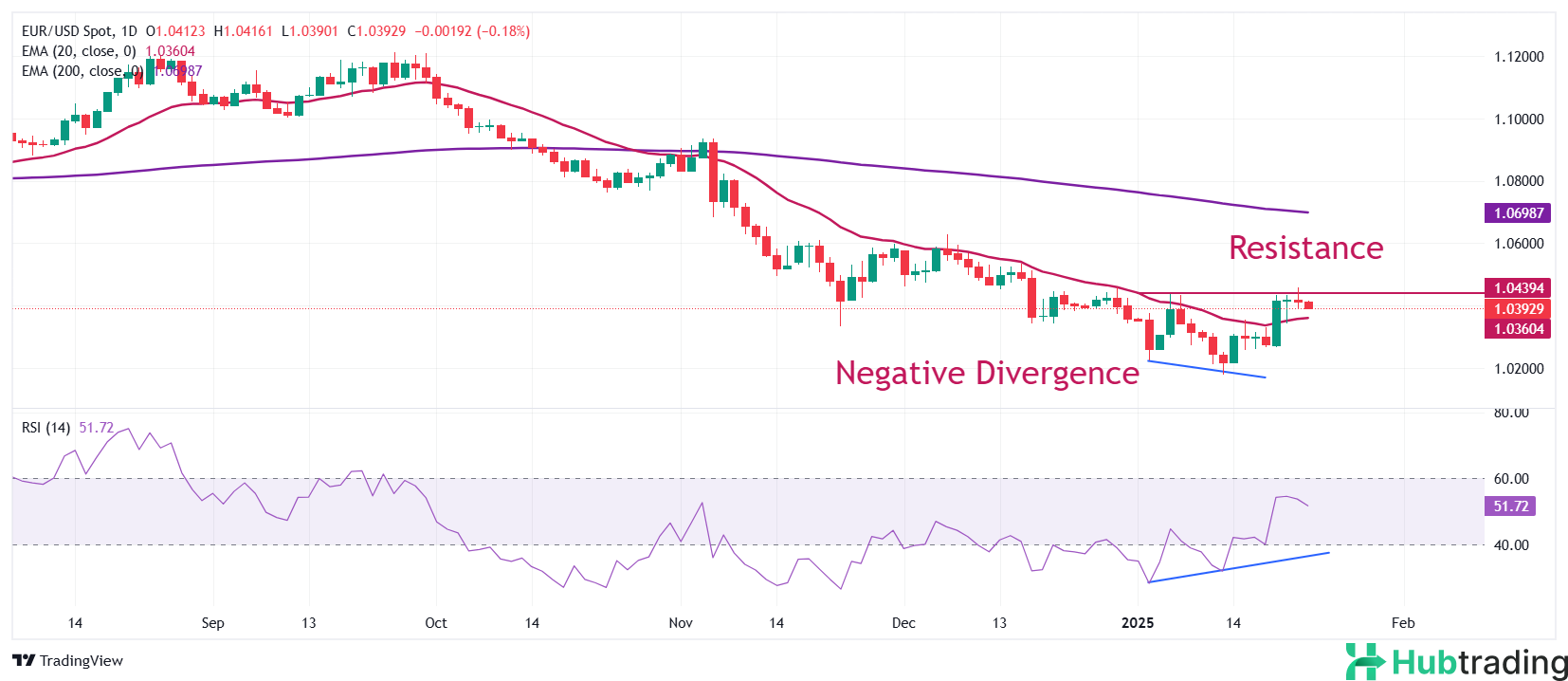- EUR/USD retreats toward 1.0400 as the US Dollar strengthens amid global growth concerns tied to Trump’s tariffs.
- ECB President Lagarde urges Europe to prepare for potential responses to Trump’s tariff increases.
- Key monetary policy announcements from the Fed and ECB are scheduled for next week, marking their first decisions of 2025.
EUR/USD edges lower toward 1.0400 during Thursday’s European session as the US Dollar (USD) strengthens. The US Dollar Index (DXY), which measures the Greenback’s performance against six major currencies, extends its rebound to 108.40 after touching a two-week low of 107.75 on Wednesday. The USD recovery comes amid cautious market sentiment as investors evaluate the potential economic impact of US President Donald Trump’s tariff policies.
Trump has announced plans for a 25% tariff on goods from Canada and Mexico and a 10% levy on Chinese imports, effective February 1. Additionally, he aims to impose tariffs on Europe, citing unfair trade practices. While these measures are less aggressive than initially feared, they still pose risks to global economic growth.
European Central Bank (ECB) President Christine Lagarde remarked in an interview with CNBC on Wednesday that Trump’s measured approach to tariffs was “smart,” as broad-based levies don’t always yield expected results. However, she cautioned that Europe must “anticipate and prepare” for potential fallout, as the tariffs are likely to be “selective” and “targeted.”
Daily Digest Market Movers: EUR/USD Dips Ahead of Eurozone-US Flash PMI Data for January
- EUR/USD Weakens: The pair edges lower on Thursday as investors turn their attention to the release of flash Eurozone and US Purchasing Managers Index (PMI) data for January, scheduled for Friday. The Eurozone HCOB PMI report, compiled by S&P Global, is expected to show continued contraction in overall business activity, albeit at a slower pace. The HCOB Composite PMI is forecast to rise slightly to 49.7 from December’s 49.6.
- US PMI Expectations: On the US side, economists anticipate steady expansion in overall business activity. While the manufacturing sector is likely to remain in contraction, the decline is expected to slow. Meanwhile, the service sector is projected to show moderate growth.
- Policy Outlooks Stir Volatility: Next week is set to bring heightened market volatility as both the Federal Reserve (Fed) and the European Central Bank (ECB) announce their first monetary policy decisions of the year. The Fed is widely expected to maintain its current interest rate range of 4.25%-4.50%, according to the CME FedWatch tool. Meanwhile, markets have fully priced in a 25-basis-point (bps) interest rate reduction by the ECB.
- ECB Commentary: Market expectations for ECB rate cuts in the next four meetings remain strong. However, ECB policymaker and Finnish central bank governor Olli Rehn expressed caution on Wednesday, stating that while he is confident inflation will stabilize at the target, monetary policy decisions will be determined on a meeting-by-meeting basis rather than following preset expectations.
Technical Analysis: EUR/USD Faces Resistance Near 1.0460

EUR/USD struggles to sustain its recovery above the immediate resistance at 1.0460, following a rebound from the two-year low of 1.0175 reached on January 13. The pair’s recovery was supported by a divergence in momentum and price action, as the 14-day Relative Strength Index (RSI) formed a higher low while the pair printed lower lows.
In the near term, the outlook has improved with the pair trading above the 20-day Exponential Moving Average (EMA), currently around 1.0360. However, the longer-term trend remains bearish, as indicated by the downward-sloping 200-day EMA at 1.0700.
On the downside, the January 13 low of 1.0175 serves as a critical support zone. On the upside, the psychological resistance at 1.0500 will be the key hurdle for Euro bulls to clear.





